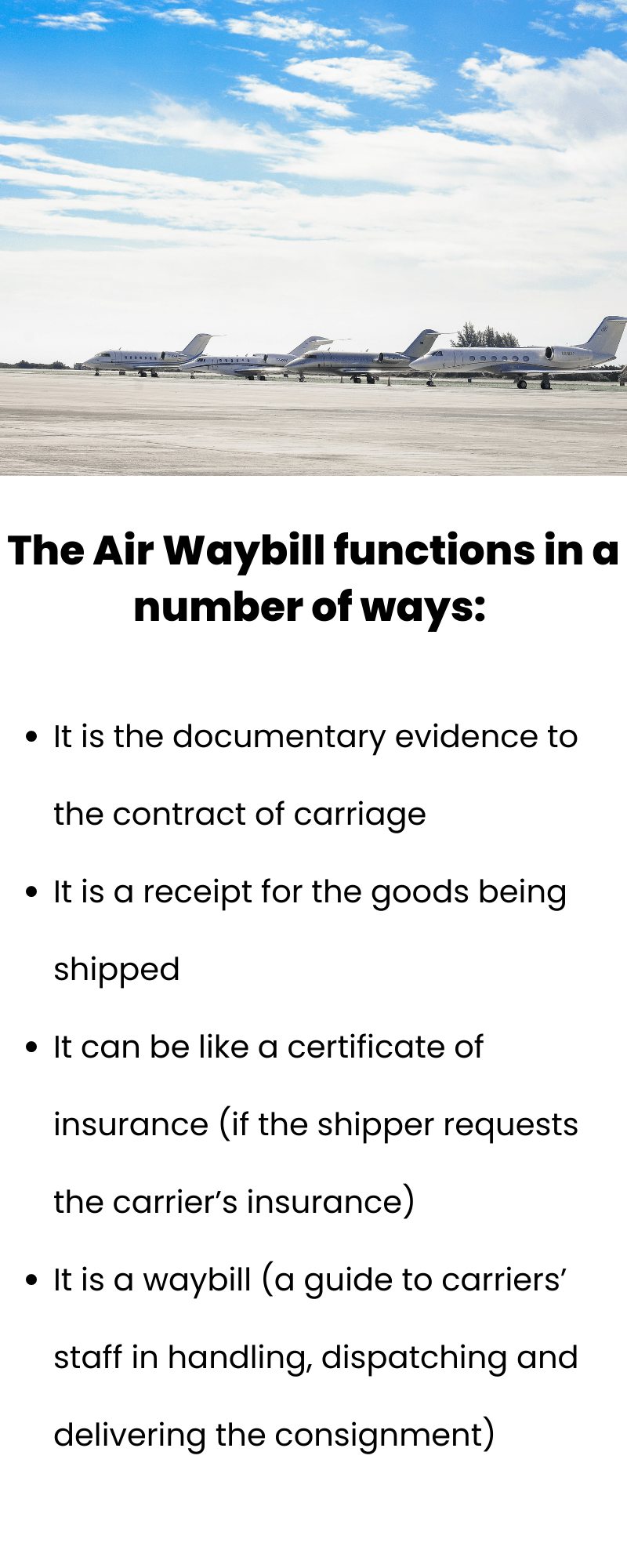The lists of the regular documents needed for Air Transport of Cargo in export and import trade are:
- Proforma Invoice
- Letter of Credit/Telex Transfer banking copy
- Commercial Invoice
- Packing List
- Certificate of Origin
- Insurance copy
- Air Waybill (AWB)
- Other shipping documents that are needed as per the rules of the country that are doing the trade of export and import
Let us focus on the Air Waybill (AWB) in this article which is the most important transportation document used for carriage of goods by air.
Table of Contents
- What is Air Waybill (AWB)?
- Master Air Waybill (MAWB)
- The Use of the Master Air Waybill
- House air Waybill (HAWB)
- Transporting Dangerous Goods
What is Air Waybill (AWB)?
An air waybill (AWB) is a non-negotiable document, which is issued by a carrier when goods are transported by air.
An air waybill acts as delivery instructions, a contract of carriage, and a cargo receipt for airfreight. If the AWB issued by the actual carrier, Airlines, it is a master air waybill (MAWB). If issued by an air freight consolidator or forwarder it is a house air waybill (HAWB).
The Air Waybill (AWB) covers the consignment from origin to destination no matter how many airlines are involved.
The air waybill functions in a number of ways:
- It is the documentary evidence to the contract of carriage
- It is a receipt for the goods being shipped
- It can be like a certificate of insurance (if the shipper requests the carrier’s insurance)
- It is a waybill (a guide to carriers’ staff in handling, dispatching and delivering the consignment).
Master Air Waybill (MAWB)
A master air waybill (MAWB) is an airline document used for individual consignments.
The documentation for dispatch of a consolidated shipment is the same as for an individual (single) shipment as far as the airlines are concerned.
In the case of a consolidation, it shows the sending agent as shipper, the destination break-bulk agent as the consignee and reveals that a multi-package, loose consolidation is being dispatched, or a single, sealed container with a specific number of shipments.
A MAWB stating “consolidation” must be accompanied by a manifest, detailing all shipments within the consolidation.
The Use of the Master Air Waybill
The air waybill may be used only for two types of transportation:
Transportation by air of individual shipments
OR
Transportation by air of consolidated shipments
For the individual shipment in a consolidated shipment, the consolidator/Freight Forwarder must use his own “house air waybill” and not the carrier’s air waybill.
The principle of consolidation is that the forwarder/consolidator assembles many shipments of various sizes, weights, and volumes, paying the carrier on the total weight of the consolidation.
It is to note that mixing volume cargo with heavy cargo increases profitability. In air freight the heavier the shipment, the lower the cost per kg.
By containerizing or palletizing, the forwarder may pay the carrier only a lump sum per ULD. The consolidator then charges the individual shippers according to his own air freight tariff at the different weight levels. In this way the freight forwarder makes a profit from the shipper (Exporter or Importer).
The air freight forwarder (consolidator) usually offers lower-than-airline rates for the same (or better) level of service.
The air waybill generally consists of three originals and five copies.
Original (3) (blue)
This copy, for the shipper (cargo agent), is given to the shipper (or cargo agent) and is to serve as: Proof of receipt of the goods for shipment
Original (1) (green)
This copy, for the issuing carrier, is to be retained by the primary carrier for accounting purposes
Original (2) (red)
This copy, for the consignee, is to accompany the consignment to its final destination and is to be tendered to the consignee upon delivery of the goods.
The shipper/exporter is responsible for the correctness of the particulars and statements relating to the goods that he inserts in the AWB, or that are inserted on his behalf. The shipper will be liable for all damage suffered by the carrier or any other person because of irregularity, incorrectness or incompleteness of those particulars and statements, regardless of whether the AWB is completed by himself, or on his behalf by the carrier or its authorized agents.
House air Waybill (HAWB)
Air freight consolidator or forwarder may issue their own air waybills for each shipment with HAWB.
These are called house air waybills, and each customer receives one to identify his/her consignment.
The airline plays no part in the terms of payment quoted on the house air waybill.
All house air waybills are forwarded with the shipment in a sealed envelope, accompanied by a load list or manifest, itemizing all the component parts by house air waybill number, so that the cargo may be identified.
Packages must show the master air waybill number, the house air waybill number and destination airport code.
To note, when completing both the HAWB and the MAWB, always ensure that the number of pieces and weight on the HAWB exactly match the total pieces and weight as indicated on the MAWB.
Transporting Dangerous Goods
When transporting dangerous goods, shippers/exporters/importers must declare their shipments as dangerous goods on the cargo air waybill (in the “Handling Information” field).
This air waybill must be accompanied by the IATA Shipper’s Declaration for Dangerous Goods form, which must be completed by the shipper/exporter.


